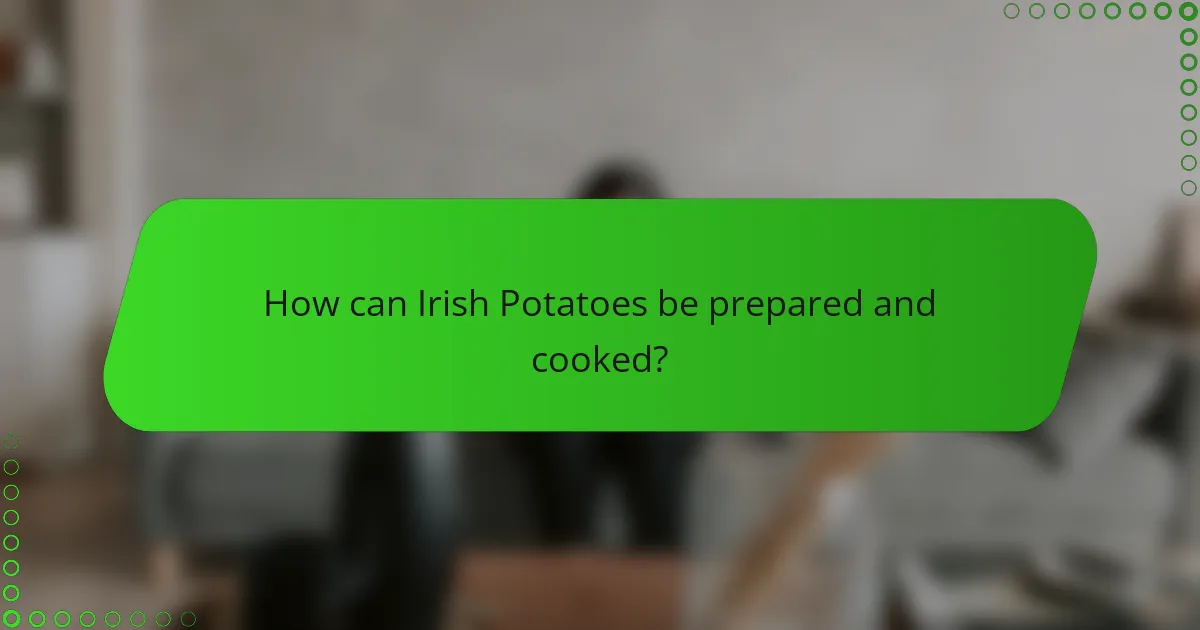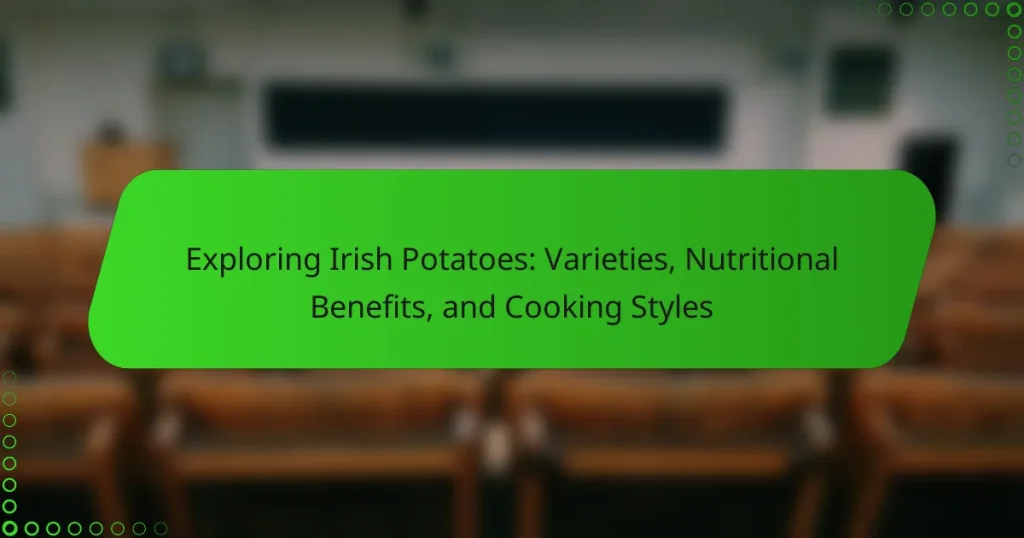Irish potatoes are a type of potato predominantly found in Ireland, characterized by their white or yellow flesh and adaptability to the local climate. Known for their versatility, they can be prepared through various cooking methods, including boiling, baking, roasting, and mashing, each enhancing their flavor and texture. Introduced to Ireland in the late 16th century, Irish potatoes became a dietary staple due to their high starch content and nutritional benefits, providing essential carbohydrates, vitamins, and minerals such as vitamin C, potassium, and dietary fiber. Proper selection and storage practices are crucial for maintaining their quality, with recommendations for selecting firm, blemish-free potatoes and storing them in a cool, dark environment. This article explores the varieties, nutritional benefits, and cooking styles associated with Irish potatoes.

What are Irish Potatoes?
Irish potatoes are a type of potato that is commonly associated with Ireland. They are primarily the white or yellow-fleshed varieties that thrive in the Irish climate. Irish potatoes are known for their versatility in cooking and are often used in traditional Irish dishes. They can be boiled, mashed, roasted, or used in soups and stews. The potato was introduced to Ireland in the late 16th century and became a staple food. Their high starch content makes them ideal for mashing and frying. In terms of nutrition, Irish potatoes are a good source of carbohydrates, vitamins, and minerals. They provide essential nutrients like vitamin C, potassium, and dietary fiber.
How do Irish Potatoes differ from other potato varieties?
Irish potatoes are distinct from other potato varieties primarily due to their unique flavor and texture. They are known for their creamy, buttery taste and smooth skin. This variety tends to be waxy, making them ideal for boiling and roasting. Unlike starchy potatoes, Irish potatoes hold their shape well during cooking. They are commonly used in traditional Irish dishes, such as colcannon and champ. The high moisture content in Irish potatoes contributes to their desirable cooking qualities. Additionally, they are often grown in the rich, volcanic soil of Ireland, enhancing their flavor profile. These attributes set Irish potatoes apart from varieties like Russet or Yukon Gold, which have different textures and culinary uses.
What are the key characteristics of Irish Potatoes?
Irish potatoes are a starchy tuber known for their versatility and flavor. They typically have a smooth, thin skin that can be either yellow or red. The flesh is usually white or yellow and has a creamy texture when cooked. Irish potatoes are rich in carbohydrates, providing a significant energy source. They are also a good source of vitamins C and B6, as well as potassium. These potatoes thrive in cool climates and are commonly grown in Ireland and other temperate regions. Their unique characteristics make them suitable for various cooking methods, including boiling, baking, and frying.
Why are Irish Potatoes significant in culinary traditions?
Irish potatoes are significant in culinary traditions due to their versatility and historical importance. They are a staple food in Ireland, forming the basis of many traditional dishes. Irish potatoes are used in recipes such as colcannon and boxty, showcasing their cultural relevance. Historically, the Great Famine in the 19th century highlighted their central role in Irish society. Today, they continue to be celebrated in various cuisines around the world. Their adaptability in cooking methods, including boiling, baking, and frying, enhances their culinary appeal. Thus, Irish potatoes are integral to both cultural heritage and modern gastronomy.
What varieties of Irish Potatoes are available?
Irish potatoes come in several varieties. Common types include Rooster, Kerr’s Pink, and Golden Wonder. Rooster potatoes are known for their versatility and good storage qualities. Kerr’s Pink potatoes are appreciated for their creamy texture and flavor. Golden Wonder potatoes are ideal for frying due to their high starch content. Other varieties include Maris Piper and British Queen, each with unique attributes. Maris Piper is favored for its consistent cooking qualities. British Queen offers a waxy texture, suitable for salads. These varieties are cultivated widely in Ireland, contributing to their popularity.
What are the most popular types of Irish Potatoes?
The most popular types of Irish potatoes include the Rooster, Kerr’s Pink, and Yukon Gold. Rooster potatoes are known for their versatility and are commonly used in various dishes. Kerr’s Pink potatoes have a distinctive pink skin and are favored for their creamy texture. Yukon Gold potatoes are recognized for their buttery flavor and yellow flesh. These varieties are widely cultivated and consumed in Ireland. They are often used for boiling, baking, and mashing. Their popularity is attributed to their taste, texture, and adaptability in cooking.
How do the flavors and textures vary among different Irish Potato varieties?
Different Irish potato varieties exhibit distinct flavors and textures. For instance, the ‘Rooster’ variety is known for its creamy texture and earthy flavor. In contrast, ‘Kerr’s Pink’ potatoes have a floury texture and a slightly sweet taste. ‘Golden Wonder’ potatoes are characterized by a dry, fluffy texture and a strong, nutty flavor.
Moreover, ‘Earlie’ potatoes tend to have a waxy texture and a mild flavor, making them ideal for salads. Each variety’s unique attributes stem from their genetic makeup and growing conditions. The differences in starch content also contribute to the varying textures. High-starch potatoes are generally fluffier, while low-starch types are waxier.
Overall, the diversity in flavors and textures among Irish potato varieties enhances their culinary versatility.
What nutritional benefits do Irish Potatoes offer?
Irish potatoes offer several nutritional benefits. They are a rich source of carbohydrates, providing energy. A medium-sized potato contains about 37 grams of carbohydrates. Additionally, they are a good source of dietary fiber, with approximately 2 grams per medium potato. This fiber aids in digestion and promotes gut health.
Irish potatoes also provide essential vitamins and minerals. They are particularly high in vitamin C, with one medium potato supplying about 30% of the daily recommended intake. This vitamin supports the immune system and skin health. Furthermore, they contain potassium, which is vital for heart health and blood pressure regulation. A medium potato has around 620 milligrams of potassium.
Moreover, Irish potatoes are low in calories, making them a healthy addition to various diets. One medium potato has roughly 160 calories. These nutritional attributes make Irish potatoes a versatile and beneficial food option.
What vitamins and minerals are found in Irish Potatoes?
Irish potatoes contain several vitamins and minerals. They are a good source of vitamin C, which supports the immune system. Additionally, they provide vitamin B6, important for brain health. Irish potatoes also contain potassium, essential for heart function. They have magnesium, which aids in muscle function. Furthermore, they offer iron, necessary for oxygen transport in the body. These nutrients contribute to the overall nutritional value of Irish potatoes.
How do Irish Potatoes contribute to a balanced diet?
Irish potatoes are a significant source of carbohydrates, which provide energy. They are rich in dietary fiber, aiding digestion and promoting gut health. Additionally, Irish potatoes contain essential vitamins, such as vitamin C, which supports the immune system. They also provide potassium, contributing to heart health and blood pressure regulation. The low-fat content of Irish potatoes makes them a healthy choice for weight management. Consuming Irish potatoes can enhance nutrient intake when included in a balanced diet. Studies show that they can help meet daily nutritional needs effectively.

How can Irish Potatoes be prepared and cooked?
Irish potatoes can be prepared and cooked in various ways. Common methods include boiling, baking, roasting, and mashing. To boil, peel and cut potatoes into uniform pieces. Place them in salted water and cook until tender, usually 15-20 minutes. For baking, scrub the potatoes, pierce them with a fork, and bake at 400°F for about 45-60 minutes. Roasting involves cutting potatoes into wedges or cubes, tossing them in oil and seasonings, and baking at 425°F until golden and crispy, typically 30-40 minutes. To mash, cook peeled potatoes until tender, then mash with butter and milk until smooth. Each method enhances the natural flavor and texture of Irish potatoes.
What are the most common cooking styles for Irish Potatoes?
The most common cooking styles for Irish potatoes include boiling, baking, and frying. Boiling is often used to prepare mashed potatoes. This method retains moisture and softens the potatoes. Baking creates a crispy skin and fluffy interior. Frying results in a crunchy texture, commonly used for chips or wedges. Each style enhances the natural flavor of the potatoes. These methods are traditional in Irish cuisine. They showcase the versatility of Irish potatoes in various dishes.
How does boiling affect the taste and texture of Irish Potatoes?
Boiling Irish potatoes makes them softer and creamier in texture. The heat breaks down the starches, resulting in a smoother mouthfeel. This process enhances their natural sweetness, making the flavor more pronounced. Boiled potatoes absorb water, which can dilute their taste if overcooked. Cooking time is crucial; typically, 15 to 20 minutes is ideal for optimal texture. Properly boiled potatoes maintain a balance of firmness and tenderness. This cooking method is common in various cuisines, showcasing the versatility of Irish potatoes.
What are the benefits of baking versus frying Irish Potatoes?
Baking Irish potatoes offers several benefits compared to frying. Baked potatoes typically contain fewer calories and less fat. This is due to the absence of added oils or fats during the baking process. For example, a medium baked potato has around 160 calories, while a medium fried potato can contain over 300 calories.
Baking also preserves more nutrients. Research indicates that boiling or frying can lead to nutrient loss, particularly vitamins like C and B6. Baked potatoes maintain these vitamins better.
Additionally, baking enhances the natural flavor of potatoes without the need for heavy seasoning. This can lead to a healthier meal overall. Baked potatoes are often considered a healthier option by nutritionists.
In summary, baking Irish potatoes provides lower calorie content, better nutrient retention, and enhanced natural flavors compared to frying.
What are some traditional Irish recipes featuring potatoes?
Colcannon is a traditional Irish dish featuring potatoes, cabbage, and butter. It dates back to the 18th century. Champ is another classic, made with mashed potatoes and scallions. This dish is often served with a well of melted butter in the center. Boxty is a type of potato pancake, combining grated and mashed potatoes. It is typically fried and served as a side dish. Irish shepherd’s pie incorporates mashed potatoes as a topping over a meat filling. This dish showcases the versatility of potatoes in Irish cuisine. Each recipe highlights the importance of potatoes in traditional Irish cooking.
How is Colcannon made, and what are its key ingredients?
Colcannon is made by mashing boiled potatoes with other ingredients. The key ingredients include potatoes, cabbage or kale, butter, and milk. First, the potatoes are peeled and boiled until soft. Then, they are drained and mashed until smooth. Cabbage or kale is cooked separately until tender. This cooked vegetable is then mixed into the mashed potatoes. Butter and milk are added for creaminess and flavor. The dish is typically seasoned with salt and pepper. Colcannon is a traditional Irish dish often enjoyed during celebrations.
What variations exist for Irish Potato Soup?
Variations of Irish Potato Soup include classic, creamy, and chunky styles. Classic Irish Potato Soup consists of potatoes, onions, and stock, blended until smooth. Creamy variations add milk or cream for richness. Chunky styles incorporate diced vegetables or bacon for texture. Some recipes use leeks instead of onions for a different flavor. Others may include herbs like thyme or chives for added freshness. Certain versions incorporate cheese for a savory twist. Seasonal variations might include ingredients like carrots or parsnips. Each variation maintains the core essence of potatoes as the primary ingredient.

What are some tips for selecting and storing Irish Potatoes?
Select Irish potatoes that are firm, smooth, and free from blemishes. Avoid potatoes with soft spots or green discoloration. Store selected potatoes in a cool, dark, and well-ventilated place. Ideal storage temperatures range from 45°F to 50°F. Do not store potatoes in the refrigerator, as cold temperatures can alter their taste and texture. Keep them in a breathable container, such as a burlap sack or paper bag. Check stored potatoes regularly for any signs of sprouting or decay. Remove any affected potatoes promptly to prevent spoilage of others. These practices help maintain the quality and flavor of Irish potatoes.
How can you choose the best Irish Potatoes at the market?
Choose firm, smooth Irish potatoes with no blemishes or sprouts. Look for uniform size for even cooking. The skin should be intact and free from cuts. Check for a slightly waxy texture, indicating freshness. Fresh Irish potatoes should feel heavy for their size. Avoid potatoes with green patches, as they may contain solanine, which is toxic. Selecting from a reputable vendor can also ensure quality.
What signs indicate freshness in Irish Potatoes?
Fresh Irish potatoes exhibit several signs of freshness. They should have smooth, firm skin without any blemishes. Fresh potatoes feel heavy for their size. There should be no sprouting or green spots present. A fresh potato has a clean, earthy smell. Additionally, fresh potatoes have a consistent shape and size. These characteristics indicate that the potatoes have been properly stored and are still good for consumption.
What are the best practices for storing Irish Potatoes at home?
Store Irish potatoes in a cool, dark, and well-ventilated area. Ideal storage temperatures range from 45°F to 50°F. Avoid exposing potatoes to direct sunlight, as this can lead to greening and bitterness. Use a breathable container, such as a burlap sack or cardboard box, to allow air circulation. Keep potatoes away from onions, as they can cause each other to spoil more quickly. Check stored potatoes regularly for signs of sprouting or decay, and remove any affected ones immediately. These practices help maintain the quality and extend the shelf life of Irish potatoes.
How long can Irish Potatoes be stored, and what conditions are ideal?
Irish potatoes can be stored for about 2 to 3 months under ideal conditions. The optimal storage conditions include a cool, dark, and well-ventilated area. Temperatures between 45°F to 50°F (7°C to 10°C) are recommended. Humidity should be around 90% to prevent shriveling. Avoid exposure to light, as this can cause greening and bitterness. Proper storage helps maintain quality and prolongs shelf life.
What common mistakes should be avoided when storing Irish Potatoes?
Common mistakes to avoid when storing Irish potatoes include exposing them to light, which causes greening and solanine production. Storing them in a humid environment can lead to rot and mold. Keeping potatoes in the refrigerator is another mistake, as cold temperatures can alter their flavor and texture. Additionally, stacking potatoes too tightly can cause bruising and damage. Finally, failing to check for spoiled potatoes can lead to contamination of healthy ones. Proper storage conditions include a cool, dark, and well-ventilated space.
What are some innovative ways to incorporate Irish Potatoes into meals?
Irish potatoes can be innovatively incorporated into meals through various methods. One way is by creating potato gnocchi, which adds a unique texture to dishes. Another method is to use them in a creamy potato soup, enhancing flavor and nutrition. Additionally, Irish potatoes can be roasted with herbs for a flavorful side dish. They can also be used in a potato salad with a twist, incorporating ingredients like avocado or bacon. Mashed Irish potatoes can be flavored with garlic or cheese for a gourmet touch. Finally, they can be spiralized to create potato noodles, offering a gluten-free alternative in pasta dishes. Each method showcases the versatility of Irish potatoes in modern cooking.
Irish potatoes, primarily white or yellow-fleshed varieties, are a staple food in Ireland known for their versatility in cooking. This article explores the distinct characteristics of Irish potatoes, including their unique flavors and textures compared to other potato varieties, as well as their nutritional benefits, such as being rich in carbohydrates, vitamins, and minerals. It covers various cooking methods, traditional recipes, and tips for selecting and storing Irish potatoes, highlighting their significance in culinary traditions and modern gastronomy. Additionally, the article details popular varieties and innovative ways to incorporate Irish potatoes into meals.


